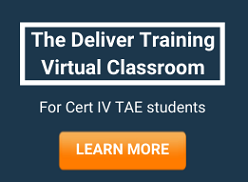About this unit.
This unit specifies the competency required to conceptualise, design, develop and evaluate learning programs to meet an identified need for a group of learners, using appropriate criteria. Criteria may include endorsed competency standards and other specifications such as organisational performance standards, product equipment specifications and workplace procedures.
The full Unit of Competency is available here.
Table of contents:
- Clarify the Purpose of the Learning Program
- Find out the Characteristics of Your Learners
- Learner Characteristics Table
- Writing a Scope Statement
- Confirming the Content of our Learning Program
- Writing Learning Objectives
- Using the SMART Formula to Write Objectives
- Choosing Resources for the Learning Program
- Develop Possible Learning Strategies
- Existing Resources Influence Our Learning Strategy
- Learner Needs Influence the Learning Strategy
- Adult Learning Styles Influence the Learning Strategy
- Other People & Operational Factors Influence our Learning Strategy
- Learning Strategy Informs the Learning Activities
- Writing a Session Plan
- Sample Session Plan Template I
- Timing our Session Plans
- Confirming and Documenting our Decisions
- Reviewing the Program
- Sample Participant Evaluation Form
This unit includes the following elements and performance criteria.
Element 1. Define the parameters of the learning program in consultation with the client/s
1.1 The purpose and focus of the learning program is clarified
1.2 Competency standards or other relevant specifications on which to base the learning program are identified, accessed and confirmed
1.3 Competency standards/other relevant specifications are read, analysed and interpreted to determine specific learning objectives/outcomes/goals, and language, literacy and numeracy requirements
1.4 The scope and breadth of the learning program is discussed and interpreted
1.5 The target group learners and their characteristics are identified and considered
1.6 Other sources of information to support the learning program are identified and accessed
1.7 The learning environment, operational resource requirements and safety implications are identified
Element 2. Generate options for designing the learning program
2.1 Relevant learning strategy documentation is accessed and used to guide the learning program development, where appropriate
2.2 The competency/educational profile and learning styles of the target group learners are investigated to inform the learning program design
2.3 Research is conducted to identify existing learning programs and/or learning resources and learning materials which could be used and/or customised
2.4 A range of options for the learning program content is generated in collaboration with other persons and based on research findings and application of learning principles
2.5 Broad time frames, possible costs and logistics of the learning program are considered
2.6 The information and ideas are evaluated and the most appropriate option/s selected
Element 3. Develop the learning program content
3.1 The specific subject matter content is researched, developed and documented in accordance with agreed design option/s and based on application of learning principles
3.2 Existing learning resources, learning materials are accessed and evaluated for content relevance and quality
3.3 Selected learning resources, learning materials are customised, where appropriate, to suit the learning purposes and audience
3.4 New, relevant and engaging learning activities and related learning materials are developed and documented, based on application of learning principles
3.5 In a learning and assessment pathway, assessment requirements for the learning program are specified
Element 4. Design the structure of the learning program
4.1 The learning content is broken into manageable chunks/segments of learning and sequenced appropriately to enhance and support effective learning and to enable achievement of identified criteria
4.2 The time frame for each segment is determined and the overall time frame is finalised
4.3 The delivery strategies and assessment methods and tools are determined/confirmed
4.4 Organisational requirements to implement the learning program are identified and documented
4.5 The learning program is finalised and documented, outlining each part of the program
Element 5. Review the learning program
5.1 The learning program draft is reviewed in collaboration with key stakeholders using an appropriate evaluation tool
5.2 The evaluation feedback is gathered, summarised and analysed to enhance the quality of the content
5.3 The draft learning program is adjusted to reflect the review outcomes, where appropriate
5.4 Final approval is obtained from appropriate personnel
5.5 The learning program documentation is held in an accessible form and updated on a regular basis following implementation and feedback









